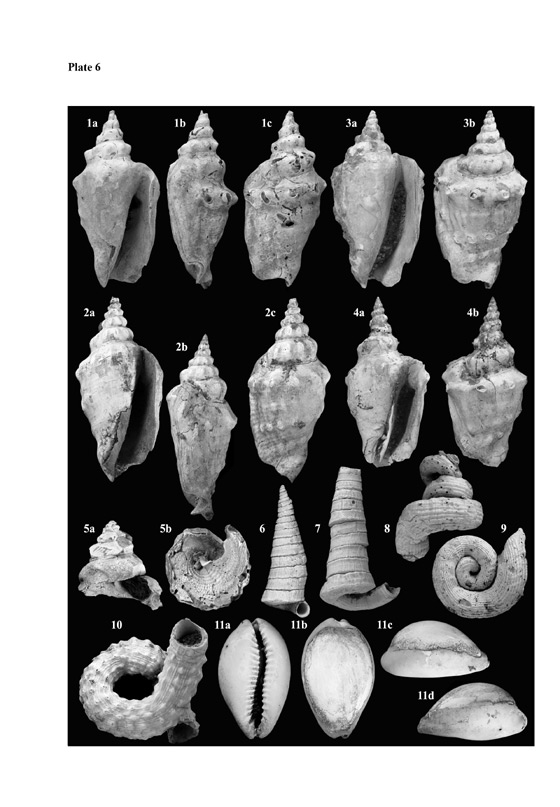
|

|
PALAEONTOS 19Price: non-members: 40 euros, members: 35 euros B. Landau & C. M. da Silva, 2010, Early Pliocene gastropods of Cubagua, Venezuela: taxonomy, palaeobiogeography and ecostratigraphy.(221 pages, 20 text-figures, 5 tables, 23 plates)Summary: A systematic account of the Early Pliocene (late Zanclean to early Piacenzian) gastropod assemblage found on the Island of Cubagua, Venezuela is given. 126 species are recorded belonging to 95 genera. Eleven species are new to science; Calliostoma (Calliostoma) calderense nov. sp., Calliostoma (Elmerlinia) pascaleae nov. sp., Calliostoma (Elmerlinia) macsotayi nov. sp., Modulus vermeiji nov. sp., Crucibulum (Crucibulum) cubaguaense nov. sp., Strombus arayaensis nov. sp., Pseudozonaria fehsei nov. sp., Mammilla arepa nov. sp., Malea beui nov. sp., Neoteron emilyvokesae nov. sp., Prunum carmengutierrezae nov. sp. Several new subjective synonymies are suggested: Turbo crenulatoides Maury, 1917 and Turbo (Marmarastoma) crenulatus venezuelensis Weisbord, 1962 = Turbo (Senectus) castanea Gmelin, 1791; Astralium brevispinum var. basalis Olsson, 1922 = Lithopoma brevispinum (Lamarck, 1822); Cerithium prismaticum Gabb, 1873 = Cerithium dentilabre Gabb, 1873, as first revisers the name Terebralia dentilabris (Gabb, 1873) is chosen; Potamides (Pyrazisinus) bolivarensis Weisbord, 1929 = Cerithium dentilabre Gabb, 1873; Pyrazisinus harrisi Maury, 1902 is a distinct species, Terebralia harrisi (Maury, 1902); Cypraea rugosa Ingram, 1947, junior homonym of C. rugosa Broderip, 1827 = Muracypraea grahami (Ingram, 1947), Cypraea caroniensis Maury, 1925 is removed from synonymy of C. henekeni G. B. Sowerby I, 1850; Xancus praeovoideus riosecanus Hodson, 1931 = Turbinella trinitatis (Maury, 1925); Vasum quirosense Hodson, 1931 = V. haitense (Sowerby, 1850); Solenosteira hasletti Anderson, 1929 and Solenosteira falconensis urumacoensis F. Hodson, 1931 = S. falconensis Weisbord, 1929; Melongena consors taurus Petuch, 1994 = Melongena consors (G. B. Sowerby I, 1850); Marginella venezuelana falconensis F. Hodson, 1927 is removed from the synonymy of Marginella venezuelana lavelana F. Hodson, 1927 and Persicula venezuelana, Persicula falconensis and Persicula lavelana, (F. Hodson in Hodson, Hodson & Harris, 1927) are considered distinct at full specific rank; Mitra (Tiara) woodringi H. E. Vokes, 1938 = Fusimitra sanctifrancisci Maury, 1925; Fusimitra sanctifrancisci and Fusimitra limonensis Olsson, 1922 are considered distinct species; Conomitra weeksi F. Hodson, 1931 = Conomitra lavelana F. Hodson, 1931; Lindoliva spengleri Petuch, 1988 and Lindoliva griffini Petuch, 1988 = Lindoliva diegelae Petuch, 1988; Conus trisculptus Pilsbry & Johnson, 1917 = Conus jaspideus Gmelin, 1791; Clavatula Fusiturricula) pagodula Rutsch, 1934 and Knefastia altenai Macsotay & Campos Villarroel, 2001 = Fusiturricula springvaleensis (Mansfield, 1925) and Architectonica catanesei Petuch, 1994 = Architectonica nobilis Röding, 1798. Patterns of extinction and local disappeance at subgenus and species level are discussed and compared to those seen in other Tropical American Neogene assemblages. The figures suggest a high degree of generic stability within the Caribbean Neogene prior to the total closure of the Central American Seaway (CAS), but a rapid turnover at specific level. The biogeography of the southern Caribbean is discussed and previous work updated. Our data again distinguish a biogeographic unit centred on the north coast of Venezuela, including the Colombian Pliocene assemblages. This group of assemblages is distinct from those found in the Isthmian region of Tropical America, and in the central Caribbean. This biogeographic unit seems to have been in place since at least the Early Miocene, and whilst showing dramatic changes in faunal composition at specific level over time, altered little at generic level until the total disappearance of the ‘paciphile taxa’, which occurred in two pulses, the first at the beginning of the Late Pliocene, the second at the end of the Early Pleistocene. The geographic expression of this unit apparently has not altered over time, and does not seem to have been greatly affected by the closure of the CAS responsible for the demise of the Gatunian Province and the subsequent rise of the Late Pleistocene to Recent Caribbean Province. Although the bioprovinces changed, the subprovince remained unaltered. This suggests that the oceanographic conditions in the region have not changed greatly since Early Miocene times, and seem not to have been significantly affected by the uplift of the Isthmus of Panama. Woodring’s (1966) concept of ‘paciphilia’ is again updated, with the addition of four further supraspecific paciphilic taxa; genera Mammilla Schumacher, 1817, Eunaticina Fischer, 1855, Neoteron Pilsbry & Lowe, 1932, and the ‘Conus (Ximeniconus)’ species group bringing the total number of known paciphilic supraspecific gastropod taxa to 67. We also give the first Neogene Atlantic record for the following living tropical American Pacific species (i.e. paciphile species): Persististrombus granulatus (Swainson, 1822), Polinices (Polinices) intemeratus (Philippi, 1851), Stramonita ‘biserialis’ ‘southern form’ and Harpa crenata Swainson, 1822. The faunal units introduced by Landau et al. (2009) based on the presence/absence of paciphiles, Gatunian Neogene Paciphile Molluscan Units (GNPMU), are revised. The Cubagua assemblage is placed within GNPMU1, with an upper age limit no later than upper Zanclean. |
|
ORDER INFORMATION:please contact us at: palaeontos@gmail.com |
|